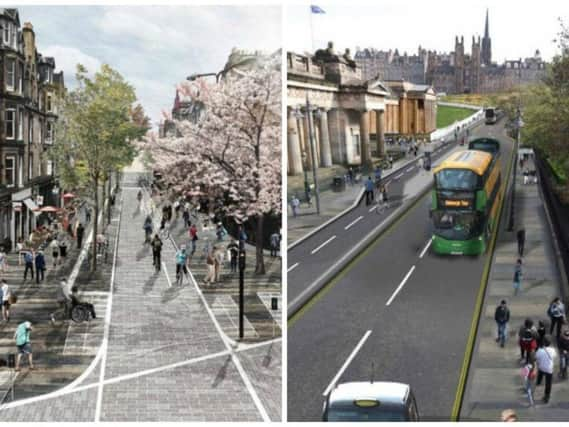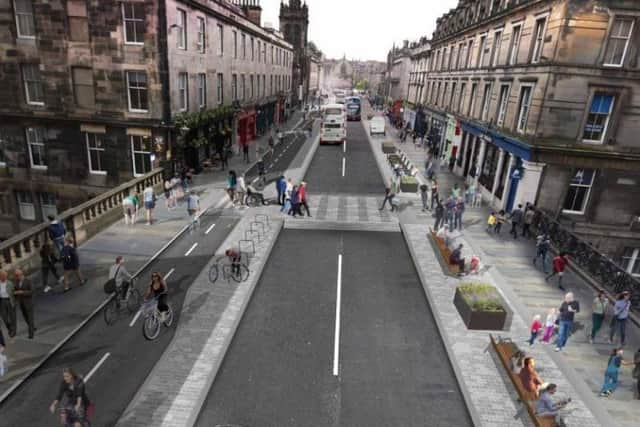Edinburgh city centre's £314m transformation plans: Everything you need to know


The plans, costing more than £300 million, were unveiled today and are due to be considered by councillors next week.
Under the "ground-breaking" 10-year strategy, Cockburn Street, Forrest Road, Victoria Street, Waverley Bridge and Lawnmarket will close to traffic - while Bank Street will be shut except for buses and taxis and Candlemaker Row will only be open to buses.


Advertisement
Hide AdAdvertisement
Hide AdThe High Street is also set to be closed to traffic between North Bridge and St Mary's Street.
And the strategy includes proposals for "reallocation of traffic lanes" on a host of streets including Cowgate, the Bridges corridor, Lothian Road, St Andrew Square and Princes Street.
There would be a widened pedestrian priority zone and a more joined-up cycling network.
And a "hopper" bus operating around the city centre will be trialled as a step towards the council's long-term aim of having more buses routed to but not through the central area.
Advertisement
Hide AdAdvertisement
Hide AdProposals for a city centre tram "spur link" to join up a network if the line is extended north to south in the future has not officially been included in the proposals, but space has been left if plans are progressed.
The Background
The council's final strategy for the Edinburgh City Centre Transformation has been published after around 80 per cent of the public backed the vision in the second round of public consultation. It will be discussed by the authority's transport and environment committee on Thursday next week.
How and when?
The first phase of the ambitious project, to take place over the next five years, includes closure of Waverley Bridge in conjunction with Network Rail's Waverley Masterplan, ambitious cycling infrastructure projects, the trial of the city centre public hopper bus and car-free streets in the Old Town.
But more than £300m will need to be found for the final phase of the strategy, which includes creating a tree-lined boulevard on Lothian Road, integrated public transport ticketing and timetabling and a new cycling and walking bridge linking Old Town and New Town.
Cost and Economic Benefits
Advertisement
Hide AdAdvertisement
Hide AdOfficials say that the project could potentially generate £420m of "quantifiable benefits" based on £314.6m of investment.
Project director Daisy Narayanan said there has been a "head in the stars, feet on the ground approach" to the vision.
She added: "Phase one of the project we have funding for already, phase two is feasibility studies which we are hoping to have about £1.5m for and phase three is £310m capital and £4m of revenue - it's a very cautious figure. It's making sure the delivery plan is rooted in reality and we can deliver it.
"If and when tram line three happens, the business case should include the spur line. As a city centre, we think that spur is necessary. It's not part of the costs, but if there's a tram line three, it is future-proofing the city centre."
Advertisement
Hide AdAdvertisement
Hide AdThe council aims to provide "a cohesive network of pedestrian priority and car-free streets connecting Waverley with key areas of the Old Town". Footpaths will be widened on key pedestrian routes - with traffic lanes removed to make way. A pedestrian priority zone would be created in the city centre "where people have priority and vehicles are guests".
The strategy also points to a "reduced volume of buses crossing the city centre without a loss in the routes served" - while bus journeys will be speeded up "through signal prioritisation and bus-stop rationalisation."
The plans are likely to be welcomed by many, including environmental campaigners, but others may be concerned about aspects of the proposals, including the impact on bus services.
Transport and environment convener, Cllr Lesley Macinnes, said: "This is broadly what we think we will be doing across 10 years. A big part of that is laying out a programme of delivery for 10 years and our funding strategy. We are building in a degree of flexibility into that.
Advertisement
Hide AdAdvertisement
Hide Ad"We really are attempting to do this in as comprehensive, informed and intelligent way to make sure we end up delivering the right thing at the right time. Everybody is moving in the same direction - we would be a foolish city if we turned around and headed back down the other side of the motorway.
"The principle of a north-south tram link is clear. But how we deliver it is based on all sorts of aspects of parliamentary legislation, our ability to purchase bits of land. There's an awful long way to us saying this is the form that north-south link would take and where it would go. There's a lot of conversation to happen."
